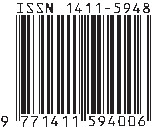Tuturan humor dalam program acara Kafe Ramadhan Jember 1 Tv: Kajian pragmatik
Abstract
Kafe Ramadhan is a program broadcasted by Jember 1 TV, adopting a situational comedy concept. This program serves as a local television initiative to understand the preferences and needs of their audience as a reference in presenting engaging and relevant shows, aiming to capture attention and maintain audience interest through the strength of humorous discourse. The purpose of this research is to identify and explain the forms of humorous discourse constructed through the violation of the principles of cooperation and politeness in the Kafe Ramadhan program. This study is a qualitative descriptive research using a method and data analysis technique employing a heuristic hypothesis framework. The results of this research indicate that humorous discourse in the Kafe Ramadhan program constitutes a violation of four maxims of cooperation principles and six maxims of politeness principles. Violations of the quality maxim were found to generate the most amusement. This demonstrates that discourse violating the submaxim of quality by stating something untrue or asserting something whose truth cannot be adequately proven mostly induces amusement. Meanwhile, violations of the maxim of tact were found to be the most prevalent among violations of other politeness principles. This proves that discourse violating the submaxim of tact by uttering something more disadvantageous and less advantageous to others mostly elicits amusement. Discourse in the Kafe Ramadhanprogram tends to involve various types of humor, including superiority, motivational, and biassociative humor.
References
Budiyanto, Dwi. 2009. “Penyimpangan Implikatur Percakapan dalam Humor-Humor Gus Dur”, Jurnal Litera, Volume 8 No. 2 hal 105-107.
Fajri, Syaiful Rizal. 2021. “Pelanggaran Maksim Kerja Sama dan Kesopanan, serta Penggunaan Daya Ironi dan Kelakar pada Video Humor Pak Ndul di YouTube (Kajian Pragmatik)”. Skripsi. Jember: Jurusan Sastra Indonesia Fakultas Ilmu Budaya Universitas Jember.
Habrani, Hendrawan Ardiansyah dan Luluk Isani Kulup. 2017. “Implikatur Percakapan Acara Humor Indonesia Lawak Klub di Trans7”, Jurnal Buana Sastra, Volume 4 No. 1 hal. 27-34.
Hardani. 2020. Metode Penelitian Kualitatif dan Kuantitatif. Yogyakarta: CV. Pustaka Ilmu Group.
Hermintoyo. 2011. “Aspek Bunyi sebagai Sarana Kreativitas Humor”, Jurnal Ilmu Budaya Universitas Diponegoro, Volume 35 No. 1.
Ifansyah, Nur dan Sumarlam. 2017. “Implikatur Wacana Humor Gelar Wicara Ini Talkshow di NET TV”, Jurnal Bahastra, Volume 37 No. 1 hal. 49-57.
Imtiyaz, Azhar Nasywa. 2020. "Implikatur Humor dalam Acara Stand Up Comedy Panji Pragiwaksono Bertajuk Juru Bicara: Kajian Pragmatik". Skripsi. Surabaya: Jurusan Bahasa Sastra Indonesia Fakultas Ilmu Budaya Universitas Airlangga.
Kamalin, Nila Fittrotul Laili. 2021. “Analisis Teknik Bahasa dan Logika Humor Gus Baha’ dalam Tayangan ‘Betapa Mudahnya Masuk Surga’ pada Channel YouTube NU Online ditinjau dari Teori Arthur Asa Berger”. Skripsi. Ponorogo: Jurusan Komunikasi dan Penyiaran Islam Fakultas Ushuluddin dan Dakwah Institut Agama Islam Negeri (IAIN) Ponorogo.
Leech, G. 1993. Prinsip-Prinsip Pragmatik. Jakarta: Universitas Indonesia Press.
Rohmadi, M. 2017. Pragmatik Teori dan Analisis. Surakarta: Yuma Pustaka.
Sugiarto, Vania Dewi. 2016. “Tenik Humor dalam Film Komedi yang Dibintangi oleh Stand Up Comedian”, Jurnal E-Komunikasi, Volume 4 No. 1.
Wijana, I Dewa Putu. 2018. Analisis Wacana Pragmatik. Surakarta: Yuma Pustaka.

This work is licensed under a Creative Commons Attribution-ShareAlike 4.0 International License.
SEMIOTIKA has CC-BY-SA or an equivalent license as the optimal license for the publication, distribution, use, and reuse of scholarly work. Authors who publish with this journal retain copyright and grant the journal right of first publication with the work simultaneously licensed under a Creative Commons Attribution-ShareAlike 4.0 International License that allows others to share the work with an acknowledgment of the work's authorship and initial publication in this journal.
Attribution-ShareAlike
CC BY-SA










